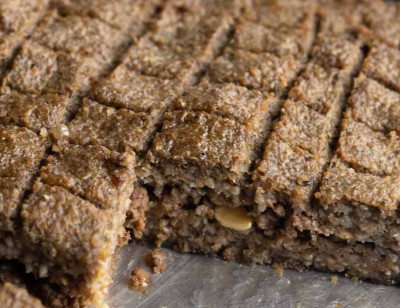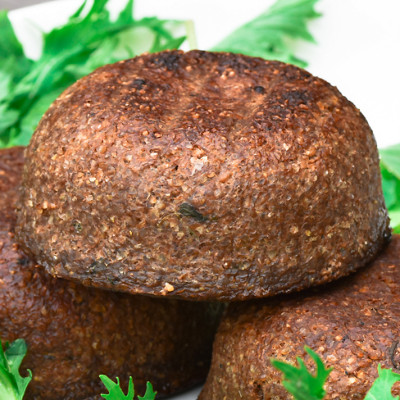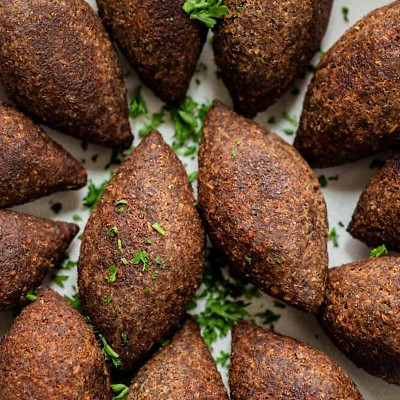Kibbeh, a dish of Lebanese cuisine
 Kibbeh is a traditional dish in Lebanon and other parts of the Middle East. It is a preparation whose main ingredient is a mixture of bourghol, and a second ingredient which is generally meat, but which can be fish or even a vegetable (such as pumpkin or potato). Kibbeh is eaten raw, fried, grilled or baked, and comes in the form of stuffed balls or pancakes, sometimes decorated with a sauce, most often with yogurt. In addition, it can be served as an aperitif, starter or main course.
Kibbeh is a traditional dish in Lebanon and other parts of the Middle East. It is a preparation whose main ingredient is a mixture of bourghol, and a second ingredient which is generally meat, but which can be fish or even a vegetable (such as pumpkin or potato). Kibbeh is eaten raw, fried, grilled or baked, and comes in the form of stuffed balls or pancakes, sometimes decorated with a sauce, most often with yogurt. In addition, it can be served as an aperitif, starter or main course.
 Traditionally, the meat was pounded in a stone mortar or tile, with ice cubes to prevent heating, then mixed by hand with the bourghol. This method has become rare as stone utensils have been replaced by the machine.
Traditionally, the meat was pounded in a stone mortar or tile, with ice cubes to prevent heating, then mixed by hand with the bourghol. This method has become rare as stone utensils have been replaced by the machine.
 Kibbeh nayyeh is a delicious Lebanese specialty prepared from raw minced meat. It is a symbol of celebration and is reserved for special days. In some mountain villages, the meat is mixed with marjoram and served with lamb confit. In the north of the country, part of the bourghol is replaced by crushed walnuts. In the South, the meat is not mixed with bourghol, it is chopped, pureed with salt and presented with kammouné: mixture of bourghol mixed with onion, mint, cumin, basil , marjoram and dried rose petals.
Kibbeh nayyeh is a delicious Lebanese specialty prepared from raw minced meat. It is a symbol of celebration and is reserved for special days. In some mountain villages, the meat is mixed with marjoram and served with lamb confit. In the north of the country, part of the bourghol is replaced by crushed walnuts. In the South, the meat is not mixed with bourghol, it is chopped, pureed with salt and presented with kammouné: mixture of bourghol mixed with onion, mint, cumin, basil , marjoram and dried rose petals.
Kibbeh bel saniyeh remains the most typical of homemade kibbehs. The kibbeh is spread on a dish and put in the oven. The best known kibbeh bel saniyeh is the one that has 2 layers, stuffed with minced meat, onion and pine nuts.
Kibbeh is cooked and prepared differently across Lebanon, reflecting local traditions and the availability of certain ingredients. In Zgharta in northern Lebanon, kibbeh el zgherteouieh is mainly prepared from goat meat and stuffed with animal fat, garlic and dried mint and usually cooked on the grill. In Tripoli and Beirut, due to the availability of seafood, fish is used instead of meat and white pepper in kebbet el samak. The dough-like mixture into oval balls or spread on the bottom of a round baking tray. Kibbeh balls are used in cooking and are an important ingredient in local soups and stews across the country. Kibbeh Arnabiyeh is one of Beirut’s most famous recipes and is usually prepared in winter. It consists of hollow kibbeh balls cooked in tahini sauce and can be eaten with rice as a side dish. The recipe includes a tahini-based sauce diluted with citrus juice made primarily from bitter oranges which enriches the flavor. Yogurt and kibbeh stew is a family favorite across the country. This recipe may have come from the Bekaa Valley, where milk was easily available. In Chouf, awarma is added to the yogurt to make it more substantial. Kibbeh balls are also eaten in kishk soup. Kishk is a bulgur yogurt fermented for several days then dried in the sun to obtain a fine powder. In southern Lebanon, particularly in Saida, kibbeh balls are stuffed with a mixture of butter, nuts and red pepper paste.
Vegetarian versions, kibbeh batata, laktin or hilleh made from potato, pumpkin or flour mixed with bourghoul and stuffed with a variety of vegetable ingredients. Christians eat these types of kibbeh during fasting and especially on Good Friday.

